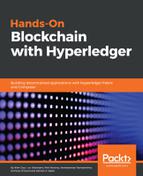So far in this chapter, we have been focusing primarily on the human side of governance. We have looked at the impact of the business model on governance, the business processes to consider, and the various potential structures, but what about the technology? What is the impact of the governance model on technology, and how does technology impact governance?
While blockchain projects might be primarily focused around solving business and enterprise issues, the foundation still relies on technology. In this section, we will look at the major phases of the life cycle of the network, from inception all the way to operation, and see how some of those activities can be automated and supported by technology.
We'll focus on the topic of on-boarding. As you now know, the system ledger is used to store the organizations, the policies, and the channels that make up the network. Storing configurations on the ledger means that any modifications need to be signed and approved. This is great from an audit perspective as it provides the configuration with the characteristics of the blockchain approach itself:
- Consensus: Configuration changes are endorsed and validated by members of the network according to the defined policies.
- Provenance: Configuration changes are signed by the initiator of the change and all other endorsers, thus preserving the provenance of the change.
- Immutable: Once the configuration block is added to the blockchain network, it cannot be modified. A subsequent transaction is required to further alter the configuration.
- Finality: As the transaction is recorded on the system ledger and distributed to all peers of the network, it provides a unique and final place to assert the configuration of the network. No need to look at configuration files to understand to which peer your anchor should communicate with.
Now while this is a highly valuable feature, it comes with a level of complexity. The high-level process to modify the configuration is as follows:
- Retrieve the latest configuration block
- Decode the configuration block and alter the configuration accordingly
- Encode the block and calculate the delta/difference compared to the previous block to establish the RW set
- Sign the transaction and share it with other participants so that they can sign it according to the network policy
- Submit the signed transaction back to the network
These steps require a good understanding of the foundation of Hyperledger Fabric and a way to track and manage the signing by other parties. Given its decentralized nature, there might be a lot of different parties that need to be involved. This is one of the reasons the on-boarding process is so important to plan properly.
Networks should ensure that they define this process and the required automation early on. While organizations may build their own, they can also rely on prebuilt solutions. In the case of IBM, the IBM blockchain platform provides the ability to streamline the governance of the network. In the next section, we will look at how the on-boarding is done with the IBM blockchain platform.
